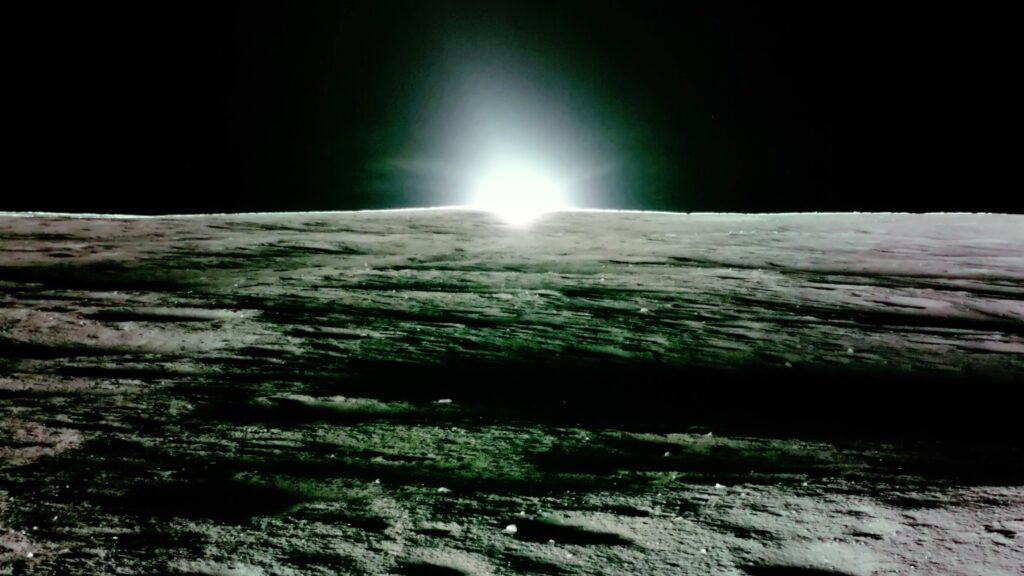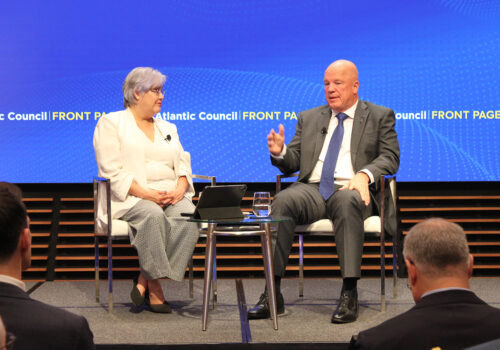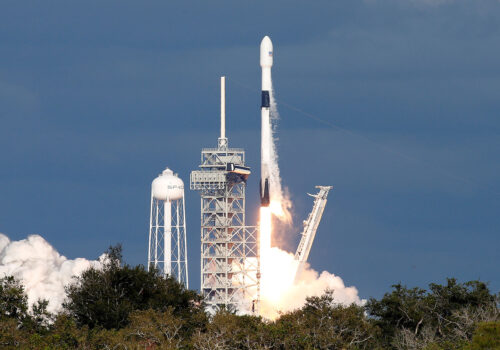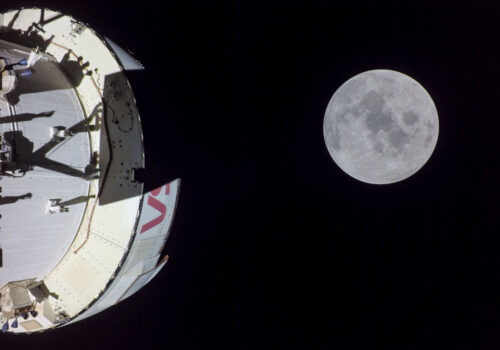A debate is taking place within the halls of the US government as to whether US astronauts should next set foot on the Moon or on Mars. While this question of “Moon versus Mars” has taken center stage in the media, there is an even more important question that needs to be asked: How should the seismic technological advances happening on Earth shape our very approach to exploring and working in space?
These technological changes necessitate a hard look at how intelligent machines and robotics should be deployed to prepare for and assist human explorers. Exploiting these technologies can accelerate discovery, enhance safety, and increase the productivity of future crewed space voyages. Additionally, if the United States chooses to synchronize technology investment in space and on Earth, we will innovate faster and accelerate exploration and discovery, all while strengthening our earthly economy and quality of life.
On Earth, a technological revolution is in full motion. Artificial intelligence (AI) and machine learning are coupling with vast computational advances to create machines that can sense, think, learn, and adapt. Machines are assisting, protecting, and replacing humans in hazardous environments and in industrial work. They’re taking on greater roles—and with more autonomy—to increase efficiency, quality, and safety across a wide array of sectors, including agriculture, mining, and manufacturing. Some robots have even taken a central role in providing the steadiest, most skillful hands for demanding surgeries. These advances are dramatically affecting how we live and work on Earth.
Lessons from Apollo: Transforming spaceflight with robotics
This technological revolution has direct applications for space travel. The US National Aeronautics and Space Administration’s (NASA’s) Artemis program, its present-day plan to return astronauts to the Moon, mimics the approach of its Apollo program from the 1960s and early 1970s. For many of those who are old enough to have witnessed the first Apollo Moon mission through black and white TV sets in 1969, the dramatic Apollo 11 lunar landing is etched into their memories. But what many likely don’t recall are the risks and challenges that had to be overcome to make such a historically groundbreaking achievement possible. For instance, the iconic Apollo 11 mission narrowly escaped disaster when its lunar module (the spacecraft intended for transporting astronauts to the Moon’s surface) missed its intended landing site. Had it not been for Apollo 11 astronaut Neil Armstrong’s skillful last-minute piloting, and a bit of luck, the mission could have gone down in history as a great tragedy.
Back then, there were no intelligent machines. Sole reliance on the adaptability of US astronauts was the best bet for accomplishing lunar exploration. It was an enormously risky venture and required extreme bravery. In certain fateful circumstances, it took extreme sacrifice from human explorers. While understandable given the technology of the 1960s and 1970s, is this still the way the United States should be approaching exploration missions in the twenty-first century?
Beyond Artemis’s schedule setbacks, cost growth, and technical challenges that are garnering headlines, there lies a fundamental question: Why is humanity still relying so heavily on humans in space, when on Earth, it is steadily learning to use intelligent, adaptable, machines to ensure safety and increase efficiencies? Should these tools not take on even more advanced roles in the “final frontier”?
This is not to suggest that humans should be removed from spaceflight. It would be a mistake to assume that robots and machines can substitute for the inspiration felt from seeing human explorers venturing into the unknown. The image of a human once again setting foot on the barren lunar landscape or an astronaut standing upon a dried Martian lakebed for the first time will generate enduring lightning bolts of wonder for young and old alike. In addition, the powerful symbolism of the astronauts of partner nations exploring together will help to bind humanity together. That said, human spaceflight is currently on the order of thirty times more costly than robotic missions. Additionally, it is questionable whether it makes sense to continue to put astronauts at high risk while there are autonomous alternatives that, at a relatively moderate cost, can increase the likelihood of success. As NASA’s Aerospace Safety Advisory Panel (ASAP) stated in its January 2025 report’s assessment of the Artemis program, “the aggregate risk associated with accomplishing so many ‘first-time’ milestones . . . may be too high.”
In several respects, the Chinese space program has proven to be more effective at integrating robotics into its space travel missions. China’s recent successful robotic lunar sample return missions indicate that they are taking a more thoughtful approach to exploration than the United States. With less investment, and in less time, than the United States, China is realizing meaningful gains through its recent Chang’e-5 and 6 lunar sample return missions. Meanwhile, the United States is struggling with the technical, cost, and schedule issues arising from the development of new rockets, complex cryogenic landers, and the intricacies of leading with crewed exploration missions.
Looking forward and reaching upward
NASA needs to forge a future in which intelligent machines and humans work together seamlessly and the strengths of each are maximized. Human spaceflight missions should focus on major events and major steps forward that evoke maximum inspiration. NASA should increase the use of robots as the workhorses of space exploration. Robotic missions should continue to lead scientific investigation and their roles should be expanded to prepare sites for human explorers, as well as to build, sustain, maintain, and operate space equipment and infrastructure in support of human presence.
Three aims should guide how NASA moves forward with integrating intelligent machines into spaceflight operations.
Modernize NASA’s organizational structure. NASA’s current organizational structure separates science from exploration and maintains separate budget lines for each. Its Science Directorate governs robotics and intelligent machines, while its Exploration Directorate focuses on human spaceflight. This artificial distinction has not withstood the test of time, as there is simply no space exploration without scientific objectives. NASA should reorganize around its main contemporary objectives and let its talented leaders across science and engineering determine the best ways to achieve them.
Reformulate NASA’s Artemis campaign. NASA should change its plan so that early flights are robotic, with work and preparations being performed by intelligent machines ahead of crewed missions. For instance, robotic missions could be used to investigate and prepare lunar landing sites, build shelters, and stock them with pre-positioned instruments, equipment, and provisions. By leading with machines rather than astronauts, the risk of dangerous landings (like those which nearly resulted in catastrophe during Apollo and ended several recent robotic missions) can be reduced. By preparing lunar habitats robotically, the first astronauts could have a shelter available upon landing, should unanticipated issues arise. This robotic integration could be lifesaving, providing modern safeguards for Artemis astronauts that would also begin to address the safety concerns recently raised by NASA’s ASAP.
To accomplish this, NASA should accelerate and build upon its Commercial Lunar Payload Services program, which has already begun to prove fruitful through recent successful partnerships such as Firefly Aerospace’s Blue Ghost Mission 1. Congress should increase funding for highly capable lunar machines that can travel large distances and move lunar rocks and soil for scientific exploration and infrastructure construction. Looking forward, humanoid robots should be used to activate the lunar base and operate equipment when astronauts are not there or are on excursions.
Equip lunar robots with virtual reality. The integration of virtual reality (VR) technologies into intelligent space exploration machines could enable scientists, engineers, and others on Earth to become active participants in the exploration of the Moon, distant planets, and beyond. These integrated VR capabilities could both increase scientific collaborations and provide indelible experiences, increasing public awareness, inspiration, and support for space exploration and science, technology, engineering, and mathematics (STEM) education.
Humanity will naturally explore. There is huge potential ahead in advancing knowledge in space science and finding ways to tap the nearly limitless resources available in space. As government leaders consider the options for the next giant leap for humankind, it behooves them to take a clearheaded look at their objectives and how they can be most efficiently and safely met. NASA should be leading the way in the international scene by driving advances in intelligent machines and robotics. In doing so, it will improve the US space program and ensure that technological investments in space are well aligned with the needs back on earth.
Dan Hart is a nonresident senior fellow at the Atlantic Council’s GeoTech Center.
Emily Sespico is an assistant director at the Atlantic Council’s GeoTech Center.
Further reading
Fri, May 9, 2025
General John Raymond on how China’s ‘space-enabled military’ threatens US and allied deterrence and warfighting
New Atlanticist By Katherine Golden
"We have to have the ability to protect those forces," Raymond said at an Atlantic Council event.
Mon, Sep 30, 2024
Could the United States’ future liftoffs take place in Africa?
AfricaSource By
By working together on expanding the roster of rocket launch sites available to the United States, Washington and its African partners can set a global standard for responsible space exploration.
Wed, Aug 14, 2024
The case for the United States and China working together in space
New Atlanticist By Dan Hart
Washington and Beijing should work to revive the idea that the exploration of space should be undertaken for peaceful purposes.
Image: An image of the moon captured by Firefly’s Blue Ghost lunar lander during Firefly Aerospace’s Blue Ghost Mission 1. March 21, 2025. Firefly Aerospace/Cover Images via Reuters Connect.




